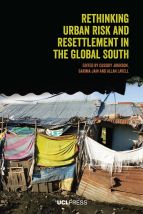Rethinking Urban Risk and Resettlement in the Global South

Rethinking Urban Risk and Resettlement in the Global South draws on empirical findings based on the collaborative research project Reducing Relocation Risk in Urban Areas. The research was led by the editors of this volume, Cassidy Johnson (principal investigator) and Garima Jain and Allan Lavell (co-principal investigators). Here, they build an empirical and theoretical basis for understanding the problem of urban risk and resettlement, and draw on empirical analysis from case studies in India, Colombia, Peru, Mexico and Uganda. The editors openly assert that they derive a view from the inside, coloured by the research this volume is based upon, and that their research is not comparative, but rather intends to conclude “about the most appropriate terms to be used in understanding and constructing typologies that lead to an understanding of causal factor, conditions for and solutions to the problem of hazard-prone urban populations” (page 4).
Sitting firmly within three strands of literature (preventative resettlement and development displacement, disaster risk management, and planning, development and resilience in urban areas of the global South), Rethinking Urban Risk and Resettlement in the Global South aims to “reflect widely on the problem of resettlement and relocation and from areas of climate and non-climatic risks” (page 9). It also “seeks to better understand the challenges and associated outcomes of such [resettlement and relocation] interventions on people and cities, and to examine ways forward for avoiding the need for resettlement or undertaking this endeavour in more holistic and integrated ways” (page 1).
Sandwiched between a comprehensive introduction and conclusion written by the editors, this book has five principal parts:
- Framing the issues (chapters 1 to 3)
- Understanding and interpreting risk (chapters 4 to 6)
- Protest and power: resistance to resettlement (chapters 7 and 8)
- Land issues in resettlement (chapters 9 to 12), and
- Natural resource and human occupation issues (chapters 13 to 15).
These parts include contributions from the aforementioned project’s team as well as those who are external but align with its area of enquiry. Each part also focuses on a particular issue of disaster risk-related relocation with some inevitable crossing of boundaries as chapters touch on multiple issues and themes.
The introduction lays the foundation for this volume and clearly outlines and summarises its content. In addition, Cassidy, Jain and Lavell outline four key findings from the project to frame the analysis of this volume (pages 11 and 12). The policy briefing that stemmed from the project is further included in Appendix B. In the conclusion, the editors synthesise and integrate the issues raised across the chapters and present lessons learnt as well as ways forward to help practitioners “develop better processes and decision-making for disaster risk reduction and resettlements” (page 17).
This volume draws upon a diverse range of cases within the framework of risk and resettlement. It has a strong empirical basis and is a very accessible and valuable resource on this complex and multi-faceted topic.
Book note prepared by Hannah Lee
Search the Book notes database
Our Book notes database contains details and summaries of all the publications included in Book notes since 1993 - with details on how to obtain/download.
Use the search form above, or visit the Book notes landing page for more options and latest content.
For a searchable database for papers in Environment and Urbanization, go to http://eau.sagepub.com/

